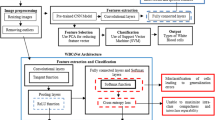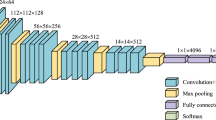Abstract
Morphologies of red blood cells are normally interpreted by a pathologist. It is time-consuming and laborious. Furthermore, a misclassified red blood cell morphology will lead to false disease diagnosis and improper treatment. Thus, a decent pathologist must truly be an expert in classifying red blood cell morphology. In the past decade, many approaches have been proposed for classifying human red blood cell morphology. However, those approaches have not addressed the class imbalance problem in classification. A class imbalance problem—a problem where the numbers of samples in classes are very different—is one of the problems that can lead to a biased model towards the majority class. Due to the rarity of every type of abnormal blood cell morphology, the data from the collection process are usually imbalanced. In this study, we aimed to solve this problem specifically for classification of dog red blood cell morphology by using a Convolutional Neural Network (CNN)—a well-known deep learning technique—in conjunction with a focal loss function, adept at handling class imbalance problem. The proposed technique was conducted on a well-designed framework: two different CNNs were used to verify the effectiveness of the focal loss function and the optimal hyperparameters were determined by fivefold cross-validation. The experimental results show that both CNNs models augmented with the focal loss function achieved higher \(F_{1}\)-scores, compared to the models augmented with a conventional cross-entropy loss function that does not address class imbalance problem. In other words, the focal loss function truly enabled the CNNs models to be less biased towards the majority class than the cross-entropy did in the classification task of imbalanced dog red blood cell data.













Similar content being viewed by others
References
Abulnaga SM, Rubin J (2018) Ischemic stroke lesion segmentation in CT perfusion scans using pyramid pooling and focal loss. In: Proceedings of the International MICCAI Brainlesion Workshop (BrainLes 2018), Granada, Spain, Springer, pp 352–363. https://doi.org/10.1007/978-3-030-11723-8_36
Baloch BK, Kumar S, Haresh S, Rehman A, Syed T (2019) Focused anchors loss: cost-sensitive learning of discriminative features for imbalanced classification. In: Proceedings of the 11th Asian Conference on Machine Learning (ACML 2019), Nagoya, Japan
Buda M, Maki A, Mazurowski MA (2018) A systematic study of the class imbalance problem in convolutional neural networks. Neural Netw 106:249–259. https://doi.org/10.1016/j.neunet.2018.07.011
Castro CL, Braga AP (2013) Novel cost-sensitive approach to improve the multilayer perceptron performance on imbalanced data. IEEE Trans Neural Netw Learn Syst 24(6):888–899. https://doi.org/10.1109/TNNLS.2013.2246188
Chawla NV, Bowyer KW, Hall LO, Kegelmeyer WP (2002) SMOTE: synthetic minority over-sampling technique. J Artif Intell Res 16:321–357. https://doi.org/10.1613/jair.953
Chy TS, Rahaman MA (2019) A comparative analysis by knn, svm & elm classification to detect sickle cell anemia. In: Proceedings of 2019 international conference on robotics, electrical and signal processing techniques (ICREST 2019), Dhaka, Bangladesh, pp 455–459. https://doi.org/10.1109/ICREST.2019.8644410
Datta S, Das S (2015) Near-bayesian support vector machines for imbalanced data classification with equal or unequal misclassification costs. Neural Netw 70:39–52. https://doi.org/10.1016/j.neunet.2015.06.005
Doi K, Iwasaki A (2018) The effect of focal loss in semantic segmentation of high resolution aerial image. In: Proceedings of the 2018 IEEE international geoscience and remote sensing symposium (IGARSS 2018), Valencia, Spain, pp 6919–6922. https://doi.org/10.1109/IGARSS.2018.8519409
Dong C, Loy CC, He K, Tang X (2015) Image super-resolution using deep convolutional networks. IEEE Trans Pattern Anal Mach Intell 38(2):295–307. https://doi.org/10.1109/TPAMI.2015.2439281
Drummond C, Holte RC et al (2003) C4.5, class imbalance, and cost sensitivity: why under-sampling beats over-sampling. In: Proceedings of Workshop on Learning from Imbalanced Datasets II, vol 11. Washington, DC, USA, pp 1–8
Durant TJ, Olson EM, Schulz WL, Torres R (2017) Very deep convolutional neural networks for morphologic classification of erythrocytes. Clin Chem 63(12):1847–1855. https://doi.org/10.1373/clinchem.2017.276345
Ford J (2013) Red blood cell morphology. Int J Lab Hematol 35(3):351–357. https://doi.org/10.1111/ijlh.12082
Garcı S, Triguero I, Carmona CJ, Herrera F et al (2012) Evolutionary-based selection of generalized instances for imbalanced classification. Knowl Based Syst 25(1):3–12. https://doi.org/10.1016/j.knosys.2011.01.012
García S, Herrera F (2009) Evolutionary undersampling for classification with imbalanced datasets: proposals and taxonomy. Evol Comput 17(3):275–306. https://doi.org/10.1162/evco.2009.17.3.275
Garcia V, Sanchez JS, Mollineda RA, Alejo R, Sotoca JM (2007) The class imbalance problem in pattern classification and learning. In: Proceedings of II Congreso Espanol de Informatica, pp 283–291
Glorot X, Bengio Y (2010) Understanding the difficulty of training deep feedforward neural networks. In: Proceedings of the 13th international conference on artificial intelligence and statistics (AISTAT 2010), Sardinia, Italy, pp 249–256
Habibzadeh M, Krzyzak A, Fevens T (2011) Application of pattern recognition techniques for the analysis of thin blood smear images. J Med Inf Technol 18
Haixiang G, Yijing L, Shang J, Mingyun G, Yuanyue H, Bing G (2017) Learning from class-imbalanced data: review of methods and applications. Expert Syst Appl 73:220–239. https://doi.org/10.1016/j.eswa.2016.12.035
Han H, Wang WY, Mao BH (2005) Borderline-SMOTE: a new over-sampling method in imbalanced data sets learning. In: Proceedings of international conference on intelligent computing (ICIC 2005), Hefei, China, Springer, pp 878–887. https://doi.org/10.1007/11538059_91
He H, Bai Y, Garcia EA, Li S (2008) ADASYN: Adaptive synthetic sampling approach for imbalanced learning. In: Proceedings of the IEEE international joint conference on neural networks (IJCNN 2008), Hong Kong, China, pp 1322–1328. https://doi.org/10.1109/IJCNN.2008.4633969
He K, Sun J (2015) Convolutional neural networks at constrained time cost. In: Proceedings of the IEEE conference on computer vision and pattern recognition (CVPR 2015), Boston, MA, USA, pp 5353–5360. https://doi.org/10.1109/CVPR.2015.7299173
He K, Zhang X, Ren S, Sun J (2016) Deep residual learning for image recognition. In: Proceedings of the IEEE conference on computer vision and pattern recognition (CVPR 2016), Las Vegas, NV, USA, pp 770–778. https://doi.org/10.1109/CVPR.2016.90
Hospedales TM, Gong S, Xiang T (2011) Finding rare classes: active learning with generative and discriminative models. IEEE Trans Knowl Data Eng 25(2):374–386. https://doi.org/10.1109/TKDE.2011.231
Huang C, Li Y, Change Loy C, Tang X (2016) Learning deep representation for imbalanced classification. In: Proceedings of the IEEE conference on computer vision and pattern recognition, Las Vegas, NV, USA, pp 5375–5384. https://doi.org/10.1109/CVPR.2016.580
Huang G, Liu Z, Van Der Maaten L, Weinberger KQ (2017) Densely connected convolutional networks. In: Proceedings of the IEEE conference on computer vision and pattern recognition (CVPR 2017), Honolulu, HI, USA, pp 4700–4708. https://doi.org/10.1109/CVPR.2017.243
Japkowicz N, Stephen S (2002) The class imbalance problem: a systematic study. Intell Data Anal 6(5):429–449. https://doi.org/10.3233/IDA-2002-6504
Kingma DP, Ba J (2014) Adam: a method for stochastic optimization. ArXiv Preprint ArXiv:14126980
Krawczyk B (2016) Learning from imbalanced data: open challenges and future directions. Prog Artif Intell 5(4):221–232. https://doi.org/10.1007/s13748-016-0094-0
LeCun Y, Bengio Y, Hinton G (2015) Deep learning. Nature 521(7553):436. https://doi.org/10.1038/nature14539
Lee H, Chen YPP (2014) Cell morphology based classification for red cells in blood smear images. Pattern Recogn Lett 49:155–161. https://doi.org/10.1016/j.patrec.2014.06.010
Lim P, Goh CK, Tan KC (2016) Evolutionary cluster-based synthetic oversampling ensemble (eco-ensemble) for imbalance learning. IEEE Trans Cybern 47(9):2850–2861. https://doi.org/10.1109/TCYB.2016.2579658
Lin TY, Goyal P, Girshick R, He K, Dollár P (2020) Focal loss for dense object detection. IEEE Trans Pattern Anal Mach Intell 42(2):318–327. https://doi.org/10.1109/TPAMI.2018.2858826
Ma Y, Sun J, Zhou Q, Cheng K, Chen X, Zhao Y (2018) CHS-NET: A cascaded neural network with semi-focal loss for mitosis detection. In: Proceedings of 10th Asian conference on machine learning (ACML 2018), Beijing, China. pp 161–175
Mazurowski MA, Habas PA, Zurada JM, Lo JY, Baker JA, Tourassi GD (2008) Training neural network classifiers for medical decision making: the effects of imbalanced datasets on classification performance. Neural Netw 21(2–3):427–436. https://doi.org/10.1016/j.neunet.2007.12.031
Pasupa K, Sunhem W (2016) A comparison between shallow and deep architecture classifiers on small dataset. In: Proceeding of the 8th International Conference on Information Technology and Electrical Engineering (ICITEE 2016), Yogyakarta, Indonesia, pp 390–395. https://doi.org/10.1109/ICITEED.2016.7863293
Qin F, Gao N, Peng Y, Wu Z, Shen S, Grudtsin A (2018) Fine-grained leukocyte classification with deep residual learning for microscopic images. Comput Methods Programs Biomed 162:243–252. https://doi.org/10.1016/j.cmpb.2018.05.024
Rahman MM, Davis D (2013) Addressing the class imbalance problem in medical datasets. Int J Mach Learn Comput 3(2):224. https://doi.org/10.7763/IJMLC.2013.V3.307
Razzak MI, Naz S (2017) Microscopic blood smear segmentation and classification using deep contour aware CNN and extreme machine learning. In: Proceedings of 2017 IEEE conference on computer vision and pattern recognition workshops (CVPRW 2017), Honolulu, HI, USA, pp 801–807. https://doi.org/10.1109/CVPRW.2017.111
Razzak MI, Naz S, Zaib A (2018) Deep learning for medical image processing: overview, challenges and the future. Classif. BioApps 26:323–350. https://doi.org/10.1007/978-3-319-65981-7_12
Rehman A, Abbas N, Saba T, Rahman SIu, Mehmood Z, Kolivand H (2018) Classification of acute lymphoblastic leukemia using deep learning. Microsc Res Tech 81(11):1310–1317. https://doi.org/10.1002/jemt.23139
Ross NE, Pritchard CJ, Rubin DM, Duse AG (2006) Automated image processing method for the diagnosis and classification of malaria on thin blood smears. Med Biol Eng Comput 44(5):427–436. https://doi.org/10.1007/s11517-006-0044-2
Russakovsky O, Deng J, Su H, Krause J, Satheesh S, Ma S, Huang Z, Karpathy A, Khosla A, Bernstein M et al (2015) Imagenet large scale visual recognition challenge. Int J Comput Vision 115(3):211–252. https://doi.org/10.1007/s11263-015-0816-y
Srivastava RK, Greff K, Schmidhuber J (2015) Highway networks. ArXiv Preprint ArXiv:150500387
Sudre CH, Li W, Vercauteren T, Ourselin S, Cardoso MJ (2017) Generalised dice overlap as a deep learning loss function for highly unbalanced segmentations. In: Proceedings of the 3rd international workshop, deep learning in medical image analysis (DLMIA 2017) and 7th international workshop in multimodal learning for clinical decision support (CDS 2017), QC, Canada, pp 240–248. https://doi.org/10.1007/978-3-319-67558-9_28
Suresh S, Sundararajan N, Saratchandran P (2008) Risk-sensitive loss functions for sparse multi-category classification problems. Inf Sci 178(12):2621–2638. https://doi.org/10.1016/j.ins.2008.02.009
Taherisadr M, Nasirzonouzi M, Baradaran B, Mehdizade A (2013) New approch to red blood cell classification using morphological image processing. Shiraz E-Med J 14(1):44–53
Tian X, Wu D, Wang R, Cao X (2018) Focal text: an accurate text detection with focal loss. In: Proceedings of the 25th IEEE international conference on image processing (ICIP 2018), Athens, Greece, pp 2984–2988. https://doi.org/10.1109/ICIP.2018.8451241
Tiwari P, Qian J, Li Q, Wang B, Gupta D, Khanna A, Rodrigues JJ, de Albuquerque VHC (2018) Detection of subtype blood cells using deep learning. Cogn Syst Res 52:1036–1044. https://doi.org/10.1016/j.cogsys.2018.08.022
Tomari R, Zakaria WNW, Jamil MMA, Nor FM, Fuad NFN (2014) Computer aided system for red blood cell classification in blood smear image. Proc Comput Sci 42:206–213. https://doi.org/10.1016/j.procs.2014.11.053
Wang S, Liu W, Wu J, Cao L, Meng Q, Kennedy PJ (2016) Training deep neural networks on imbalanced data sets. In: Proceedings of 2016 international joint conference on neural networks (IJCNN 2016), Vancouver, BC, Canada, pp 4368–4374. https://doi.org/10.1109/IJCNN.2016.7727770
Weiss GM (2004) Mining with rarity: a unifying framework. ACM SIGKDD Explor Newsl 6(1):7–19. https://doi.org/10.1145/1007730.1007734
Xu M, Papageorgiou DP, Abidi SZ, Dao M, Zhao H, Karniadakis GE (2017) A deep convolutional neural network for classification of red blood cells in sickle cell anemia. PLoS Comput Biol 13(10):e1005746. https://doi.org/10.1371/journal.pcbi.1005746
Yue S (2017) Imbalanced malware images classification: a CNN based approach. ArXiv Preprint ArXiv:170808042
Zhang C, Tan KC, Li H, Hong GS (2018) A cost-sensitive deep belief network for imbalanced classification. IEEE Trans Neural Netw Learn Syst 30(1):109–122. https://doi.org/10.1109/TNNLS.2018.2832648
Zhang X, Fang Z, Wen Y, Li Z, Qiao Y (2017) Range loss for deep face recognition with long-tailed training data. In: Proceedings of the IEEE international conference on computer vision (ICCV 2017), Venice, Italy, pp 5409–5418. https://doi.org/10.1109/ICCV.2017.578
Zhao J, Zhang M, Zhou Z, Chu J, Cao F (2017) Automatic detection and classification of leukocytes using convolutional neural networks. Med Biol Eng Comput 55(8):1287–1301. https://doi.org/10.1007/s11517-016-1590-x
Zhou ZH, Liu XY (2006) Training cost-sensitive neural networks with methods addressing the class imbalance problem. IEEE Trans Knowl Data Eng 18(1):63–77. https://doi.org/10.1109/TKDE.2006.17
Zong W, Huang GB, Chen Y (2013) Weighted extreme learning machine for imbalance learning. Neurocomputing 101:229–242. https://doi.org/10.1016/j.neucom.2012.08.010
Acknowledgements
We would like to thank the Veterinary Teaching Hospital, Kasetsart University, Hua Hin, Thailand for providing us with stained glass slides of peripheral blood smear and for labelling the dataset.
Author information
Authors and Affiliations
Corresponding author
Additional information
Publisher's Note
Springer Nature remains neutral with regard to jurisdictional claims in published maps and institutional affiliations.
Rights and permissions
About this article
Cite this article
Pasupa, K., Vatathanavaro, S. & Tungjitnob, S. Convolutional neural networks based focal loss for class imbalance problem: a case study of canine red blood cells morphology classification. J Ambient Intell Human Comput 14, 15259–15275 (2023). https://doi.org/10.1007/s12652-020-01773-x
Received:
Accepted:
Published:
Issue Date:
DOI: https://doi.org/10.1007/s12652-020-01773-x




